Last updated: June 26, 2023
Article
Thomas Jefferson's Plan for the University of Virginia: Lessons from the Lawn (Teaching with Historic Places)
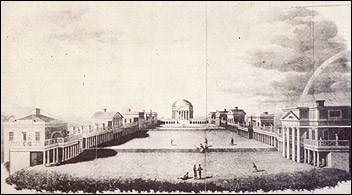
It is safer to have the whole people respectably enlightened than a few in a high state of science and the many in ignorance.
--Thomas Jefferson
Although Thomas Jefferson did not begin the effort of designing the University of Virginia in Charlottesville until late in his life, the education of the common man had occupied his thoughts for decades. He believed ignorance to be the enemy of freedom, and he wanted to correct what he considered to be the defects of educational institutions modeled on European settings and curriculum. He imagined that an "academical village" clustered around a tree-lined lawn would provide an ideal setting in which to pursue higher education. The focal point of such a village would be a Temple of Knowledge that would house the university library.
When the Virginia Legislature authorized a state university in 1818, the retired U.S. President finally was able to dedicate his intellect, time, and energy to creating this new kind of educational institution. By the time he was finished with his design, Jefferson had invented a uniquely American setting for higher education: the college campus.
About This Lesson
This lesson is based on the National Register of Historic Places registration file, "University of Virginia Historic District" (with photographs), and other primary and secondary materials about Thomas Jefferson and the creation of the University of Virginia. Mary Hughes, University Landscape Architect, Office of the Architect, University of Virginia, and Sara Wilson, formerly a research assistant in the Office of the Architect, wrote the lesson. Jean West, education consultant, and the Teaching with Historic Places staff edited the lesson. TwHP is sponsored, in part, by the Cultural Resources Training Initiative and Parks as Classrooms programs of the National Park Service. This lesson is one in a series that brings the important stories of historic places into classrooms across the country.
Where it fits into the curriculum
Topics: This lesson plan focuses on Thomas Jefferson's belief about the role of education in a democratic society, and the relationship between learning and educational setting. The lesson could be used in U.S. history, social studies, and geography courses in units on Thomas Jefferson and his democratic principles or the history of education in America.
Time period: Late 18th and early 19th century
United States History Standards for Grades 5-12
Thomas Jefferson's Plan for the University of Virginia: Lessons from the Lawn
relates to the following National Standards for History:
Era 4: Expansion and Reform (1801-1861)
-
Standard 3A- The student understands the changing character of American political life in "the age of the common man."
Curriculum Standards for Social Studies
(National Council for the Social Studies)
Thomas Jefferson's Plan for the University of Virginia: Lesson From the Lawn
relates to the following Social Studies Standards:
Theme I: Culture
-
Standard A - The student compares similarities and differences in the ways groups, societies, and cultures meet human needs and concerns.
-
Standard B - The student explains how information and experiences may be interpreted by people from diverse cultural perspectives and frames of reference.
-
Standard C - The student explains and give examples of how language, literature, the arts, architecture, other artifacts, traditions, beliefs, values, and behaviors contribute to the development and transmission of culture.
-
Standard D - The student explains why individuals and groups respond differently to their physical and social environments and/or changes to them on the basis of shared assumptions, values, and beliefs.
-
Standard E - The student articulates the implications of cultural diversity, as well as cohesion, within and across groups.
Theme II: Time, Continuity and Change
-
Standard D - The student identifies and uses processes important to reconstructing and reinterpreting the past, such as using a variety of sources, providing, validating, and weighing evidence for claims, checking credibility of sources, and searching for causality. Standard F - The student uses knowledge of facts and concepts drawn from history, along with methods of historical inquiry, to inform decision-making about and action-taking on public issues.
Theme III: People, Places and Environments
-
Standard A - The student elaborates mental maps of locales, regions, and the world that demonstrate understanding of relative location, direction, size, and shape.
Theme IV: Individual Development and Identity
-
Standard B - The student describes personal connections to places associated with community, nation, and world.
-
Standard D - The student relate such factors as physical endowment and capabilities, learning, motivation, personality, perception, and behavior to individual development.
-
Standard G - The student identifies and interprets examples of stereotyping, conformity, and altruism.
-
Standard H - The student works independently and cooperatively to accomplish goals.
Theme V: Individuals, Groups, and Institutions
-
Standard A - The student demonstrates an understanding of concepts such as role, status, and social class in describing the interactions of individuals and social groups.
-
Standard B - The student analyzes group and institutional influences on people, events, and elements of culture.
-
Standard C - The student describes the various forms institutions take and the interactions of people with institutions.
-
Standard D - The student identifies and analyzes examples of tensions between expressions of individuality and group or institutional efforts to promote social conformity.
-
Standard E - The student identifies and describes examples of tensions between belief systems and government policies and laws.
-
Standard F - The student describes the role of institutions in furthering both continuity and change.
-
Standard G - The student applies knowledge of how groups and institutions work to meet individual needs and promote the common good.
-
Standard H - The student explains and applies concepts such as power, role, status, justice and influence to the examination of persistent issues and social problems.
Theme VI: Power, Authority and Governance
-
Standard A - The student examines issues involving the rights, roles and status of the individual in relation to the general welfare.
Theme IX: Global Connections
-
Standard B - The student analyze examples of conflict, cooperation, and interdependence among groups, societies, and nations.
-
Standard F -The student demonstrate understanding of concerns, standards, issues, and conflicts related to universal human rights.
Theme X: Civic Ideals and Practices
-
Standard D - The student practice forms of civic discussion and participation consistent with the ideals of citizens in a democratic republic.
-
Standard F - The student identifies and explain the roles of formal and informal political actors in influencing and shaping public policy and decision-making.
-
Standard J - The student examine strategies designed to strengthen the "common good," which consider a range of options for citizen action.
Objectives for students
1) To determine how Jefferson's decisions about the physical design of the University of Virginia were expressive of his democratic ideals and hopes for the new nation.
2) To identify how and why Jefferson's curriculum for the University of Virginia differed from the traditional course of study offered in other universities at the time.
3) To examine how the design of local schools reflects its designers' ideas about education.
Materials for students
The materials listed below either can be used directly on the computer or can be printed out, photocopied, and distributed to students. The maps and images appear twice: in a smaller, low-resolution version with associated questions and alone in a larger version.
1) two maps of Virginia and the Charlottesville area;
2) three readings about Thomas Jefferson and the University of Virginia;
3) four drawings of educational settings at Princeton and the University of Virginia;
4) two photos of the University of Virginia.
Visiting the site
The University of Virginia is located in Charlottesville, Virginia. Guided tours of the Rotunda and the Lawn are provided year-round, except during the three-week holiday break in December/January. Tours are free of charge and meet daily at 10:00 a.m., 11:00 a.m., 2:00 p.m., 3:00 p.m., and 4:00 p.m. at the Rotunda entrance facing the Lawn. For more information, please visit the University of Virginia web pages.
Getting Started
Inquiry Question
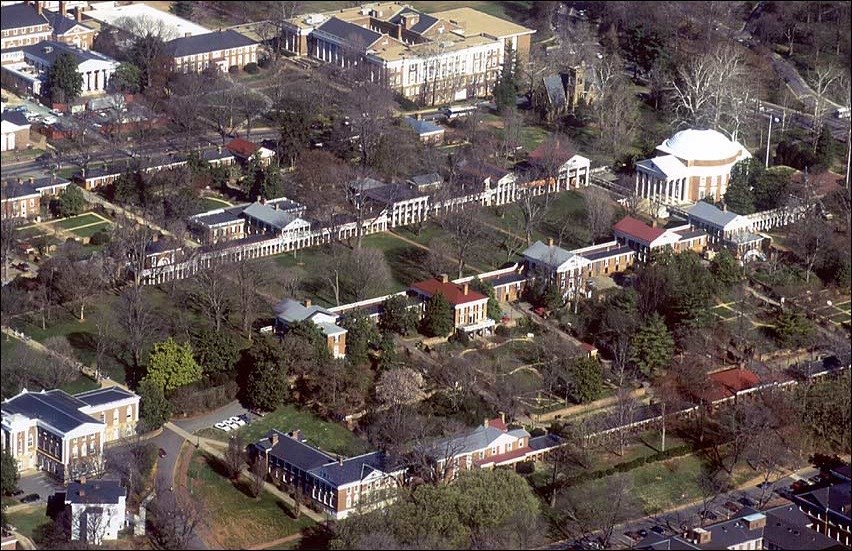
What do you think these buildings are used for?
Setting the Stage
Thomas Jefferson (1743-1826) described the founding of the University of Virginia in Charlottesville as "the last act of usefulness I can render" to the new nation.¹ After leaving Washington, D.C. in 1809, Jefferson resumed his advocacy for a cause that had occupied his thoughts since before the American Revolution, the implementation of a state-wide system of education in Virginia that would insure the education of the common man rather than just the elite of the state. He joined a group interested in founding an academy in Charlottesville, Virginia, near his home at Monticello. Jefferson expanded the project to the establishment of a private college, Central College, which was chartered in 1816.
Although the Virginia Legislature refused to fund a general plan for primary and secondary education, it finally approved $15,000 in 1818 to establish a state university. The governor appointed Jefferson to the Rockfish Gap Commission which was responsible for selecting a site for the university, choosing plans, and executing them. After debating the issue, the commission confirmed Jefferson's Charlottesville college project to be the site of the new university. The Legislature named and chartered the University of Virginia on January 25, 1819. It finally opened on March 7, 1825, although construction on the Rotunda and other projects continued after Jefferson's death on July 4, 1826.
¹Andrew Lipscomb and Albert Bergh, editors, The Writings of Thomas Jefferson, 20 Volumes, (Washington, D.C.: 1903-1904), 15:326.
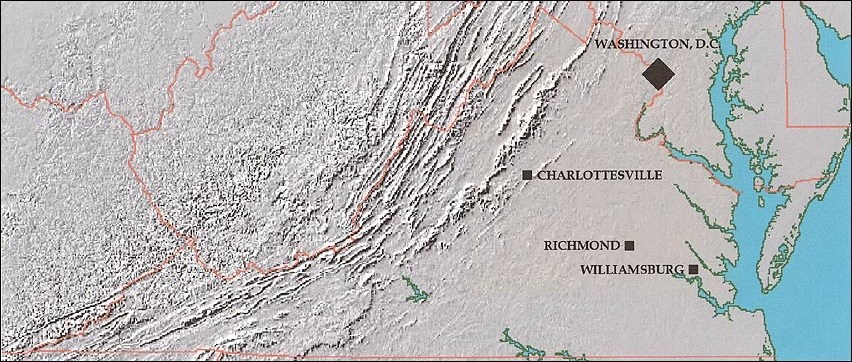
Charlottesville is in the Piedmont region of Virginia, about 75 miles west of Richmond, the state capital. In selecting the site for the new state university, Jefferson proposed "a healthier and more central position" than Williamsburg (the location of the College of William and Mary). He suggested that the university might be located "perhaps in the neighborhood of this place [Monticello]."¹
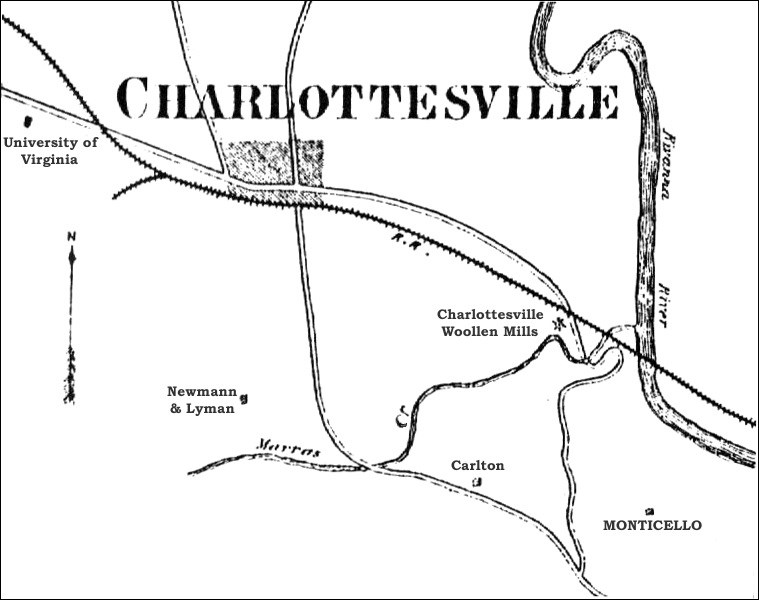
The site which was ultimately selected for the University of Virginia was a piece of land one mile west of Charlottesville that was once owned by James Monroe. The land consisted of farm fields and woodlands amidst the rolling countryside of Albemarle County. It is consistent with Jefferson's long-standing dislike of city life that he chose a rural location removed from the established town. While the University was being built, Jefferson frequently rode the four mile distance from his home at Monticello to the worksite to survey the construction.
Questions for Maps 1 & 2
1. Locate Williamsburg, Richmond, Charlottesville, and Washington, D.C. on Map 1.
2. What advantages did Jefferson see in locating the university in the western part of Virginia? What disadvantages might there have been in selecting Charlottesville, as opposed to Williamsburg or Richmond, given 18th-century transportation?
3. The University of Virginia is located a mile outside of Charlottesville. Suggest reasons why Jefferson would prefer a rural setting to an urban one (such as the state capital at Richmond).
¹Richard Guy Wilson, ed., Thomas Jefferson's Academical Village: The Creation of an Architectural Masterpiece (Charlottesville: Bayly Art Museum of the University of Virginia, 1993), 13.
Determining the Facts
Reading 1: Education as the Keystone to the New Democracy
Thomas Jefferson believed that the young nation's survival as an independent democracy absolutely depended upon its success in educating the people. His experiences in Europe as Minister to France (1784-1789) allowed Jefferson to draw direct comparisons between his new country and "the old world" of Europe. Writing from Paris in 1786 to George Wythe, his former law professor at the College of William and Mary, he described America's unique social and political setting and outlined the importance of public education to America's future.
. . . If all the sovereigns of Europe were to set themselves to work to emancipate the minds of their subjects from their present ignorance and prejudices . . . a thousand years would not place them on that high ground on which our common people are now setting out. [Our people] could not have been so fairly put into the hands of their own common sense, had they not been separated from their own parent stock and been kept from contamination, either from them, or the other people of the old world, by the intervention of so wide an ocean. To know the worth of this, one must see the want of it here. I think by far the most important bill in our whole code is that for the diffusion of knowledge among the people. No other sure foundation can be devised for the preservation of freedom, and happiness. If any body thinks that kings, nobles or priests are good conservators of the public happiness, send them here. It is the best school in the universe to cure them of that folly. ...Preach, my dear Sir, a crusade against ignorance; establish and improve the law for educating the common people. Let our countrymen know that the people alone can protect us against these evils, and that the tax which will be paid for this purpose is not more than the thousandth part of what will be paid to kings, priests and nobles who will rise up among us if we leave the people in ignorance. . . .1
Thomas Jefferson understood "that knowledge is power, that knowledge is safety, that knowledge is happiness."2 However, it is important to remember that in Thomas Jefferson's lifetime, there was no system of public education like we have today. Only the children of wealthy families could receive the tutoring required to attend a university. This limitation of educational opportunities meant that only the wealthier members of society could achieve positions of leadership. Jefferson felt strongly that the control of power by the wealthy posed a threat to America's democracy. This larger issue was a topic of heated debates chiefly between Jefferson--who felt that the government should be composed of the most virtuous and talented citizens, rich or poor--and Alexander Hamilton--who felt only the wealthy, and therefore educated, elite should rule on behalf of the common people. In a letter to John Adams written in 1813, Jefferson described how a public education system would contribute toward replacing "artificial aristocracy," or leadership based on wealth, for "a natural aristocracy" based on merit:
. . . I agree with you that there is a natural aristocracy among men. The grounds of this are virtue and talents. . . . There is also an artificial aristocracy, founded on wealth and birth without either virtue or talents; for with these it would belong to the first class. The natural aristocracy I consider as the most precious gift of nature, for the instruction, the trusts, and government of society. And indeed, it would have been inconsistent in creation to have formed man for the social state, and not to have provided virtue and wisdom enough to manage the concerns of society. . . .3
In the same letter, Jefferson described a public education bill he submitted in 1779:
And had another which I prepared been adopted by the legislature, our work would have been complete. It was a bill for the more general diffusion of learning. This proposed to divide every county into wards of five or six miles square, like your townships; to establish in each ward a free school for reading, writing and common arithmetic; to provide for the annual selection of the best subjects from these schools, who might receive, at the public expense, a higher degree of education at a district school; and from these district schools to select a certain number of the most promising subjects, to be completed at an university, where all the useful sciences should be taught. Worth and genius would thus have been sought out from every condition of life, and completely prepared by education for defeating the competition and birth for public trusts.
Although Jefferson's bill for a system of public education was not voted into law by the Virginia legislature, he remained committed to these ideas. In 1796, he submitted a similar bill, achieving only limited success. The legislature agreed only to the establishment of elementary schools, subject to each county's discretion. Jefferson lamented the fact that even this action was ineffective due to the funding provisions:
One provision of the bill was that the expenses of these schools should be borne by the inhabitants of the county, everyone in proportion to his general tax-rate. This would throw on wealth the education of the poor; and the justices, being generally of the more wealthy class, were unwilling to incur that burden, and I believe it was not suffered to commence in a single county.4
In a letter to Thaddeus Kosciusko from 1810, Jefferson expressed his continued hopes for a system of public education:
I have indeed two great measures at heart, without which no republic can maintain its strength. 1. That of general education, to enable every man to judge for himself what will secure or endanger his freedom. 2. To divide every county into hundreds, of such size that all the children of each will be in reach of a central school in it.5
Additional years passed by before sufficient legislative interest in higher education allowed Jefferson to use his political skills to press, once again, for establishment of a public university in Virginia. On February 21, 1818, a year after the bill had been introduced, the Virginia Legislature finally passed the law to establish a public university. Recalling that 39 years had passed since the introduction of his first more comprehensive public education bill, Jefferson nonetheless celebrated the law establishing the university as "a bantling [baby] of forty years birth and nursing."6
Questions for Reading 1
1. Why is it significant that Jefferson wrote his letter to George Wythe from Paris in 1786?
2. In his letter to George Wythe, Jefferson drew some comparisons between America with Europe. What did he feel were the advantages of being an American citizen?
3. What were the dangers Jefferson associated with an uneducated nation?
4. What were the components to the system of public education that Jefferson proposed? What inequalities was it meant to address?
5. Why did the established aristocracy resist Jefferson's attempts to create a public school system?
6. Explain Jefferson's beliefs about the relationship between education and democracy. Do you think these beliefs helped Jefferson remain committed to public education? Explain.
Reading 1 was compiled from Bernard Mayo, ed., Jefferson Himself: The Personal Narrative of a Many-Sided American (Charlottesville, Va.: University Press of Virginia, 1942); Merrill D. Peterson, ed., The Portable Thomas Jefferson (New York: Penguin Books, 1975); and Andrew Lipscomb and Albert Bergh, editors, The Writings of Thomas Jefferson, 20 Volumes, (Washington, D.C.: 1903-1904).
1Andrew Lipscomb and Albert Bergh, editors, The Writings of Thomas Jefferson, 20 Volumes, (Washington, D.C.: 1903-1904), 5:396.
2Bernard Mayo, ed., Jefferson Himself: The Personal Narrative of a Many-Sided American (Charlottesville, Va.: University Press of Virginia, 1942), 324.
3Lipscomb, The Writings of Thomas Jefferson, 13:399.
4Ibid., 1:70.
5Ibid., 12:369.
6Mayo, Jefferson Himself, 326.
Determining the Facts
Reading 2: Building the Academical Village
Jefferson's early experiences and observations about education led him to conclude that the practice of housing students, faculty, classrooms, and dining halls in a single large building was not a satisfactory arrangement. While serving as President, Jefferson wrote a letter to Littleton Tazewell, one of the delegates to the Virginia Legislature, offering his observations on a proposal to create a new state university:
...the greatest danger will be their overbuilding themselves by attempting a large house in the beginning, sufficient to contain the whole institution. Large houses are always ugly, inconvenient, exposed to accident of fire, and in bad cases of infection. A plain small house for the school & lodging of each professor is best. These connected by covered ways out of which the rooms of the students should open would be best. These may then be built as they shall be wanting. In fact, an University should not be a house but a village. This will much lessen their first expenses.1
After retiring from the Presidency, Jefferson's thoughts about an ideal university were taking clear shape, even though Virginia's state representatives had not yet passed legislation to create a system of public education:
No one more sincerely wishes the spread of information among mankind than I do, and none has greater confidence in its effect towards supporting free and good government. I, am sincerely rejoiced, therefore, to find that so excellent a fund has been provided for this noble purpose in Tennessee.... I consider the common plan [for colleges] followed in this country, but not in others, of making one large and expensive building, as unfortunately erroneous. It is infinitely better to erect a small and separate lodge for each professorship, with only a hall below for his class and two chambers above for himself; joining these lodges by barracks for a certain portion of the students, opening into a covered way to give a dry communication between all the schools. The whole of these arranged around an open square of grass and trees would make it what it should be in fact, an academical village.... Much observation and reflection on these institutions have long convinced me that the large and crowded buildings in which youths are pent up are equally unfriendly to health, to study, to manners, morals, and order.2
Once the law establishing the university was enacted, Thomas Jefferson personally transformed his ideas into reality. He applied his remarkable intellect to design a university whose physical presence and course of studies would produce an educated citizenry capable of defending the freedom and democracy of the new United States of America. Jefferson produced beautiful neoclassical plans, including those for the five pavilions to house faculty and students which he designed in an astonishing 15 days. He enthusiastically described his plans to mathematician Nathaniel Bowditch in his letter of October 26, 1818:
The legislature passed an act establishing a university, endowing it for the present with an annuity of fifteen thousand dollars and directing commissioners to meet to recommend a site, a plan of buildings...etc.... The plan of building is not to erect one single magnificent building to contain everybody and everything, but to make of it an academical village in which every professor should have his separate house [called 'pavilions'], containing his lecturing room with two, three, or four rooms for his own accommodation according as he may have a family or no family, with kitchen, garden, etc.; distinct dormitories for the students, not more than two in a room; and separate boarding houses [called hotels] for dieting them by private housekeepers. We concluded to employ no professor who is not of the first order of the science he professes, that when we can find such in our own country we shall prefer them and when we cannot we will procure them wherever else to be found.3
Jefferson not only drew the architectural plans of the buildings but also made the four-mile trip between his home, Monticello, and the University on horseback almost every day to oversee construction. The elder statesman was as attentive to detail as he was to the overall concept; for example, he stipulated that the university's bronze bell have an acoustical range of two miles, and he also designed the brickyard to supply the university's construction.
Construction of the university was slow and plagued by tight budgets, religious and political opposition, and critics of the university's aesthetics. Nonetheless, by the time the University opened its doors to the first 125 students in 1825, 10 pavilions had been constructed to house the first professors and their families. A colonnaded passageway bordered the east and west sides of the Lawn (the central open space), connecting the two-story pavilions with the adjacent student dormitory rooms. The south end of the Lawn was intentionally left open to views of the mountains beyond. At the head of the Lawn stood the Rotunda, an impressive domed structure, which housed the University library. This building was modeled on a famous Roman temple, the Pantheon, which had been built between 118 and 128 A.D. Two rows of secondary buildings, known as the East and West Range, were constructed parallel to the Lawn. The Range contained more student rooms interspersed with 6 dining halls, linked again by a covered passageway. Between the buildings of the Lawn and the Range Jefferson included gardens enclosed by serpentine brick walls that were shared by the professors and hotelkeepers (the families who ran the student dining halls). Thomas Jefferson had succeeded in taking his ideals about education and democracy, transforming them into a working plan, and producing the University of Virginia.
Questions for Reading 2
1. What did Thomas Jefferson not like about the traditional practice of housing all university functions in a single building?
2. Describe the major components of the "academical village" envisioned by Thomas Jefferson.
3. How did the rural, western setting of the University of Virginia and its ground plan reflect Jefferson's ideas about education and American's future?
1Letter from Thomas Jefferson, Washington, D.C., to Littleton Waller Tazewell, January 5, 1805, Special Collections Department, University of Virginia Library, Charlottesville, Va.
2Andrew Lipscomb and Albert Bergh, editors, The Writings of Thomas Jefferson, 20 Volumes, (Washington, D.C.: 1903-1904), 12:388.
3Letter from Thomas Jefferson, Monticello, to Nathaniel Bowditch, October 26, 1818, Papers of Thomas Jefferson, Library of Congress, Washington, D.C.
Determining the Facts
Reading 3: Jefferson's Philosophy of Education
Thomas Jefferson was as interested in the curriculum of the university as the architecture. Other existing American universities were closely tied to religious institutions, since the main purpose of higher education was the instruction of church clergymen. Jefferson believed, instead, that the primary focus of the curriculum should be scientific knowledge. Keeping with Jefferson's views that religious instruction be kept separate from university studies, he included neither church nor chapel in his design. Instead, the library stood, physically and symbolically, at the center of the plan, housed in the Rotunda. Jefferson also developed a list of 7,000 books to be acquired to fill the library building he had created. This in itself was revolutionary because libraries were not important features of other institutions where learning was based on students' recitation of facts memorized from professors' lectures.
In contrast, Jefferson believed that students should draw their own conclusions from hearing lectures, reading books, observing nature, and conducting scientific experiments. For this reason, he instituted an innovative elective system at the University of Virginia, rather than a fixed curriculum. There were no required courses; the students were free to choose from the available offerings. Jefferson explained, "This institution of my native state, the hobby of my old age, will be based on the illimitable freedom of the human mind to explore and to expose every subject susceptible of its contemplation."1
In the 1818 Report of the Commissioners for the University of Virginia, Jefferson first described the purpose of primary and secondary education, which was to provide every citizen with the skills necessary to transact his own business and understand his civic rights and obligations. He then outlined the purpose of higher education, which he identified to be:
To form the statesmen, legislators and judges, on whom public prosperity and individual happiness are so much to depend; To expound the principles and structure of government, ...and a sound spirit of legislation, which...shall leave us free to do whatever does not violate the equal rights of another; to harmonize and promote the interests of agriculture, manufactures and commerce...; to develop the reasoning faculties of our youth, enlarge their minds, cultivate their morals, and instill into them the precepts of virtue and order; to enlighten them with mathematical and physical sciences, which advance the arts and administer to the health, the subsistence and comforts of human life; and, generally, to form them to habits of reflection and correct action, rendering them examples of virtue to others and of happiness within themselves. These are the objects of that higher grade of education, the benefits and blessings of which the Legislature now propose to provide for the good and ornament of their country....Encouraged, therefore, by the sentiments of the Legislature,...we present the following tabular statement of the branches of learning which we think should be taught in the University,...each of which are [sic] within the powers of a single professor:
I. Languages, ancient...
II. Languages, modern...
III. Mathematics, pure:
IV. Physico-mathematics...(applied mathematics), astronomy, geography
V. Physics, or natural philosophy, chemistry, mineralogy
VI. Botany, zoology
VII. Anatomy, medicine
VIII. Government,...History
IX. Law, municipal
X. ...General Grammar, Ethics,...fine arts2
The curriculum of the University directly affected its physical development, as described in this newspaper account, ghost written by Jefferson himself:
I rode to the grounds and was much pleased with their commanding position & prospect. A small mountain adjacent is included in their purchase, & is contemplated as a site for an astronomical observatory, and a very remarkable one it will certainly be. The whole purchase is of 200 acres which, besides an Observatory and building grounds, will afford a garden for the school of botany, and an experimental farm for that of agriculture.3
Unfortunately, Jefferson died before his plans for the botanical garden were carried out, and the experimental farm and agriculture school did not appear on the University landscape until 1870. Once again, Jefferson's ideas were far ahead of his time.
The buildings themselves were intended to serve as three dimensional lessons in architecture for the students, as Jefferson explained in a letter to William Thornton, the designer of the U.S. Capitol building, "These pavilions...shall be models of taste and good architecture, and a variety of appearance, no two alike, so as to serve as specimens for the architectural lectures."4
Jefferson considered "good architecture" to be those buildings which were based on classical models of Greek and Roman architecture. Although the buildings of the "Academical Village" were made of local materials, such as brick and wood, their design incorporated many classical features such as domes, columns, and "temple front" porticoes. These elements were the visual expression of Jefferson's democratic and republican political values.
Although he did not live to see the work completed, Jefferson was enormously proud of his contribution to Virginia's public university. When he wrote the epitaph for his grave marker, Jefferson omitted the fact that he had served two terms as President of the United States and instead recorded that he was: Author of the Declaration of American Independence, Of the Statute of Virginia for Religious Freedom, and the Father of the University of Virginia.
Questions for Reading 3
1. How was the importance of the library expressed in the physical form of the University design?
2. Are you surprised by any of the subjects listed in the proposed curriculum for the University of Virginia? Why or why not?
3. How did the University's academic program reflect Mr. Jefferson's goal of promoting "the illimitable freedom of the human mind"?
Reading 3 was compiled from Bernard Mayo, ed., Jefferson Himself: The Personal Narrative of a Many-Sided American (Charlottesville, Va: The University Press of Virginia, 1942); Merrill D. Peterson, ed., The Portable Thomas Jefferson (New York: Penguin Books, 1975); and The Jefferson Papers, Library of Congress.
1Paul Leicester Ford, ed., The Writings of Thomas Jefferson, 10 volumes, (New York, 1892-1899), 12:181.
2Thomas Jefferson, Report for the Commissioners for the University of Virginia, August 4, 1818, Special Collections Department, University of Virginia Library.
3Letter from Thomas Jefferson, Monticello, to Thomas Ritchie, August 28, 1817, Papers of Thomas Jefferson, Library of Congress, Washington, D.C.
4Letter from Thomas Jefferson, Monticello, to William Thornton, May 9, 1817, Special Collections Department, University of Virginia Library.
Visual Evidence
Drawing 1: College of New Jersey, Princeton, 1764.
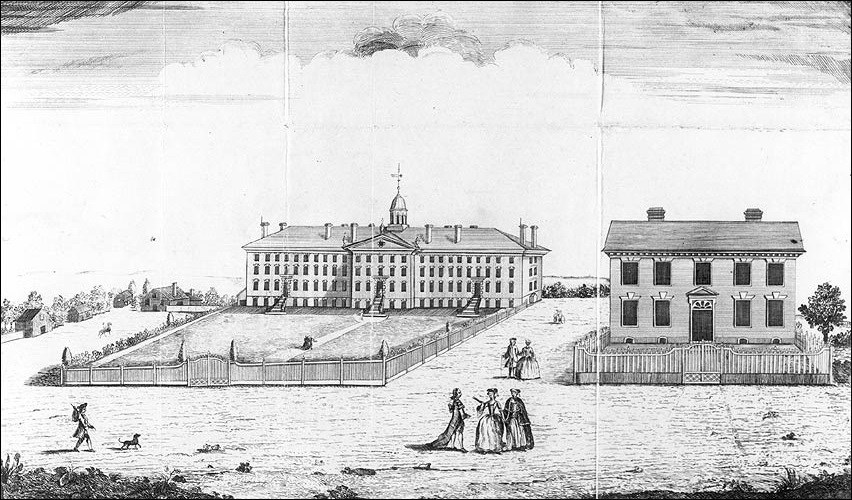
Henry Dawkins engraved this view of Princeton University with Nassau Hall to the left. Designed and built between 1755-57, the building contained a chapel, library, dining hall, kitchen, and dormitory rooms which also served as recitation chambers.
Drawing 2: The University of Virginia, 1826.
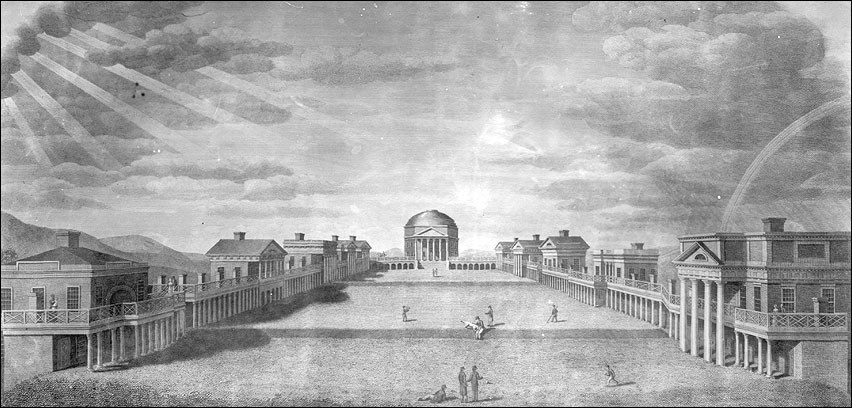
The site on which the University of Virginia was developed was typical of the rolling hills of the Piedmont countryside, and the campus layout was developed to fit the sloping ground. Jefferson described the site in a letter to U.S. Capitol architect Benjamin Latrobe in 1817: The site...is on a narrow ridge, declining from north to south, so as to give us a width between the 2 rows of pavilions of 200 feet only from East to West, and the gentle declivity [slope] of the ridge gives us three levels of 255 feet each from North to South, each about 3 feet lower than the one next above....1
Questions for Drawings 1 & 2
1. Compare Drawings 1 and 2. What differences do you observe in the design of these two universities?
2. In Drawing 2, how can you tell the difference between the professors' residences and the student dormitories? What features do they have in common?
3. Do the pavilions in Drawing 2 look identical, or not? Why do you think they were designed this way?
4. What elements of the architectural design of the pavilions made them "models of good taste and architecture" in Jefferson's mind?
5. What are the people doing on the Lawn in Drawing 2? What does this reveal to you about the way the Lawn was used?
1Thomas Jefferson to Benjamin Latrobe, August 3, 1817.
Visual Evidence
Drawing 3: Plan of the University of Virginia, January-February 1825.
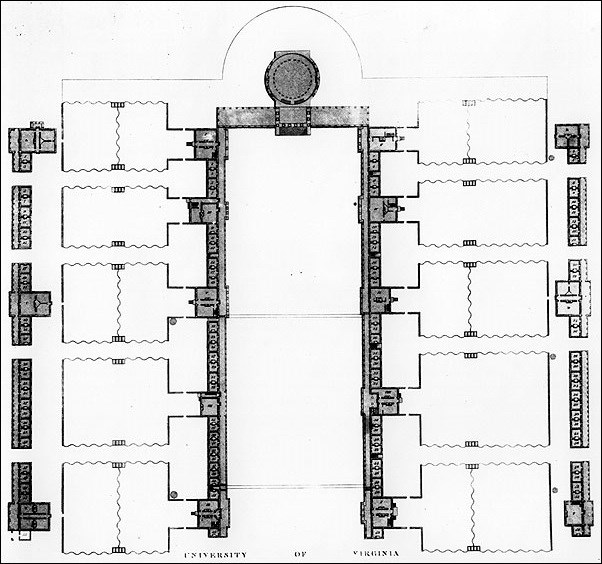
Mr. Jefferson commissioned this engraving of the University of Virginia to record its plan as it evolved during the 9 years of construction. John Neilson was the draughtsman and Peter Maverick the engraver.
Questions for Drawing 3
1. Identify the major elements of the "Academical Village" plan. Locate the Rotunda, the Lawn, the Pavilions, the Range, the dormitories, and the gardens.
2. How many Pavilions are on this plan? Explain the significance of this number.
3. How do Drawings 2 and 3 help you understand the design you have been reading about? How do the written accounts help you make sense of the visual evidence? Why is it important to have both written accounts and visual evidence?
Visual Evidence
Drawing 4: Study for Anatomical Theatre by Thomas Jefferson, c. February 1825.
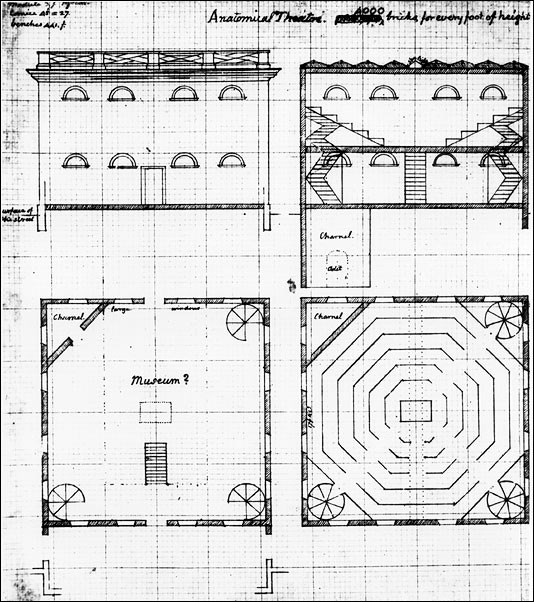
(The Papers of Thomas Jefferson, The Albert & Shirley Small Special Collections Library, University of Virginia Library)
In support of its innovative course of study, the University's design included some very unusual buildings. Shortly before his death in 1826, Mr. Jefferson designed an Anatomical Theatre where human cadavers could be used as the basis for anatomy lessons. This building, one of only three such structures in the nation at the time, was built in 1827 and stood on the campus until it was demolished in 1938.
Questions for Drawing 4
1. What does the name "Anatomical Theatre" tell you about the way this building was used?
2. At the time, no other university campus had a building of this type. Why do you think Jefferson felt the need to build such a structure at the University of Virginia?
Visual Evidence
Photo 1: Students on the Lawn, 19th Century.
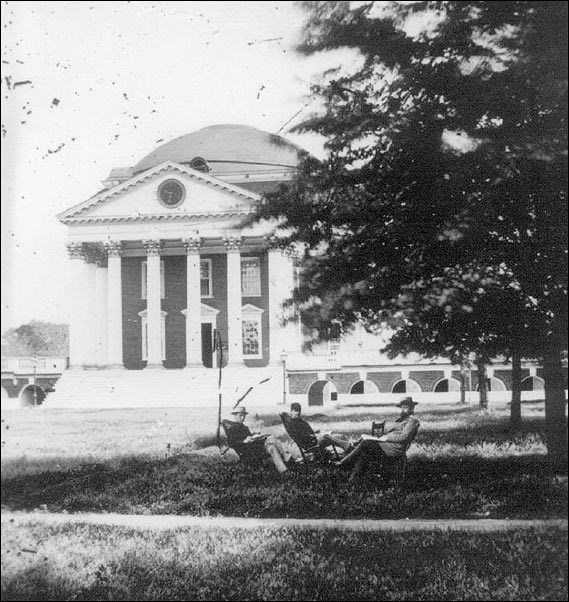
Questions for Photo 1
1. The three students shown in Photo 1 were representative of the University's student body. What does this indicate about the availability of education to the public in this period?
2. Does the make-up of the 19th-century student body seem to contradict Mr. Jefferson's democratic principles? Explain your answer.
Visual Evidence
Photo 2: Aerial view of the Lawn today.

(Photograph by Dan Grogan)
The University of Virginia has thrived in the years since its initial construction under the watchful eye of its founder. Jefferson's "Academical Village" remains the core of the campus which has grown to a current population of approximately 18,000 students.
Questions for Photo 2
1. Identify the major components of Jefferson's plan and then compare this photo with the historic plans in Drawing 2. What changes do you notice?
2. Note the chapel to the left of the Rotunda, which was built in 1889. Why wasn't a chapel included in Jefferson's original plan? Why do you think one was eventually built?
Putting It All Together
The following activities engage students in a number of ways that let them discover how Jefferson's ideas about public education continue to have an impact on their academic environment and lives.
Activity 1: A Village for Learning
Hold a classroom discussion based on the following topic: Thomas Jefferson described the University of Virginia as an "Academical Village." What image does the term "village" evoke in your mind? What aspects of the university's design contribute to its village-like character? In your opinion, is a village a good or bad model for a school today? Explain.
Activity 2: Local Schools
Coordinate with the people in your school or community, including the school media center, the local history museum, records managers for the school board, and former students and faculty, to enable your students to research the history of their school. You may wish to divide large classes into smaller groups or teams since some research facilities may not be able to accommodate large groups. Students should attempt to find out information such as:
-
The name of the architect or architectural firm that designed the school. If possible locate and study the architectural plans and determine if any changes have been made since the school was designed. If the architect is still practicing, invite him or her to speak to the class about his or her intentions for the design of the building(s) and grounds. If this is not possible, have the students hypothesize what they think the architect's intentions were at the time.
-
How the name of the school was selected, who it was named after, if applicable, and how the school mascot, nickname, and colors originated.
-
Who constructed the school, when, and for what price.
-
If there was an inaugural ceremony when the cornerstone was set or the first class entered the school, and what happened at the ceremony. If there was no ceremony, students may want to suggest why none was held. If the first principal or retired teachers from the school would be willing to share their recollections, try to arrange for them to speak to the class.
-
If there has ever been a major renovation due to damage or modernization.
-
Evaluate the impact of the school design on their learning.
-
Suggest structural, decorative, or landscape changes that might improve the school.
Ask students to share their findings in a written report, oral presentation, computer slide-show, model or exhibit.
Activity 3: Education Through the Generations
Ask students to interview their parents, or people from an earlier generation, about the school(s) they attended when they were the students' age. Questions to which they should try to find answers might include:
-
What were some of the physical characteristics of the school and grounds?
-
What was the school curriculum? What was the grading scale?
-
What rules governed the school, including dress codes?
-
What was the student body and faculty like, in terms of gender, ethnicity, race and religion?
Then, have students compare the information they have gathered about past schools with the information they have learned about their own school. Questions to address include:
-
Were there differences that can be accounted for because of geographical location?
-
What changes in the school curriculum can you identify?
-
What changes in the makeup of the student body and faculty can you identify?
-
What differences do you find in the design of the school building and grounds?
-
What reasons and events might explain these changes?
Ask students to present their findings either in an exhibit, computer slide show, oral presentation, or written report.
Thomas Jefferson's Plan for the University of Virginia: Lessons from the Lawn--
Supplementary Resources
By looking at Thomas Jefferson's Plan for the University of Virginia: Lessons from the Lawn , students will learn about the multifaceted intellect of Thomas Jefferson and how he fused his abilities as an architect, educational and political theorist, and politician to create a revolutionary new setting for higher education in the new American republic. Those interested in learning more will find that the Internet offers a variety of interesting materials.
Thomas Jefferson Online Resources at the University of Virginia
The Thomas Jefferson Digital Archive provides links to the writings of Thomas Jefferson, his plans for the construction of the university, electronic exhibits about the University that include letters from Edgar Allan Poe describing life at the University, and photographs of the University of Virginia and its buildings over the years.
Thomas Jefferson Papers
The Thomas Jefferson Papers at the Library of Congress, an institution that thrived under Jefferson's tutelage and benefited from his vast collection which the library purchased in 1815, is home to 27,000 original Jefferson documents, the largest collection in the world.
Monticello, The Home of Thomas Jefferson
The Monticello website offers information about Jefferson, the working plantation which surrounded the home and grounds he designed, and resources which give insight into Jefferson's personality and mind.
Library of Congress: Historic American Buildings Survey (HABS)/ Historic American Engineering Record (HAER) Collection
Search the HABS/HAER collection for detailed drawings, photographs, and documentation from their architectural survey of the University of Virginia. HABS/HAER is a division of the National Park Service.
UNESCO's World Heritage Program
The United Nations Educational, Scientific and Cultural Organization (UNESCO) established the World Heritage program in 1972 in an effort to ensure that future generations can inherit the natural and cultural treasures of the past. The University of Virginia is among the hundreds of World Heritage Sites designated thus far. Visit the program's Web pages to learn more about these sites.
Tags
- thomas jefferson
- presidential history
- university of virginia
- virginia
- virginia history
- higher education
- education history
- architectural history
- teaching with historic places
- twhp
- national register of historic places
- nrhp listing
- american presidents
- art and education
- federal
- mid 19th century
- american president
- education
- twhplp
